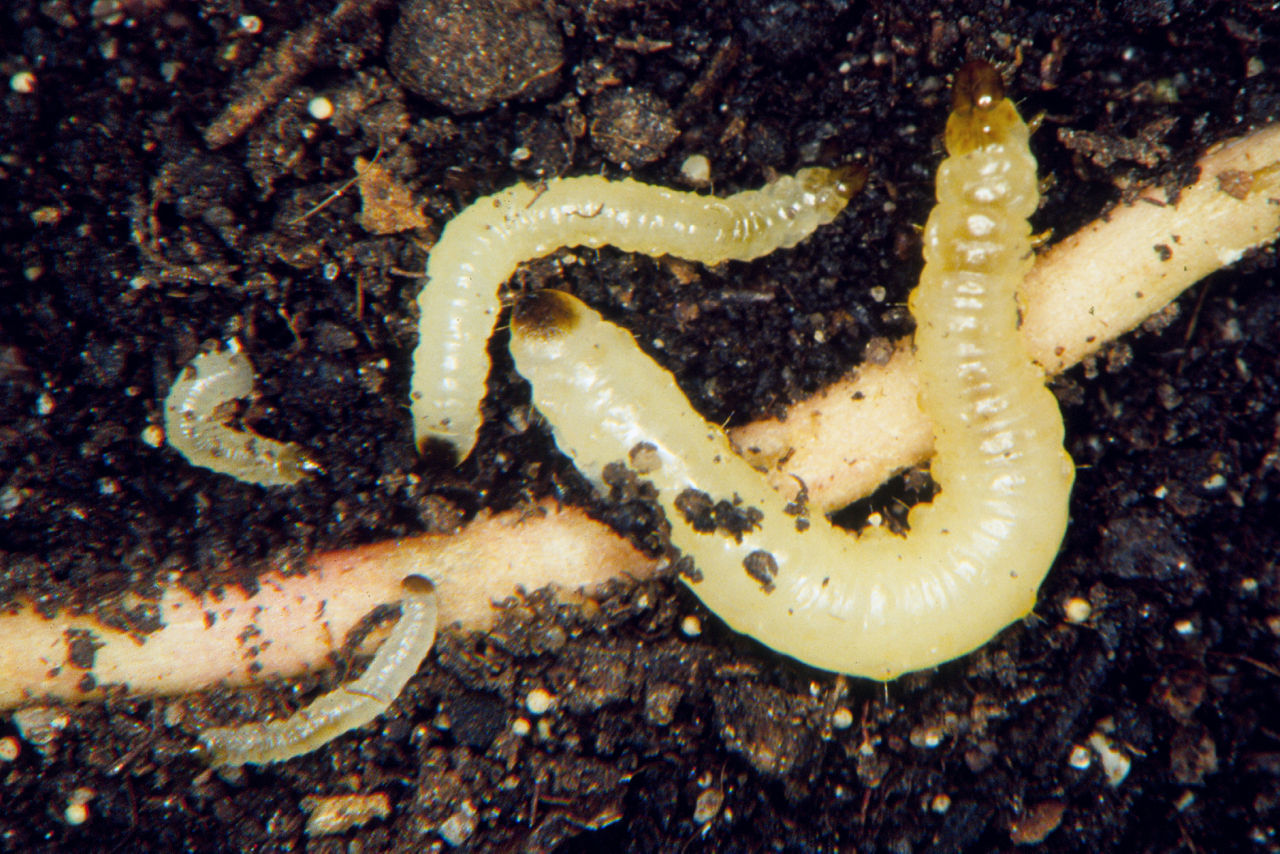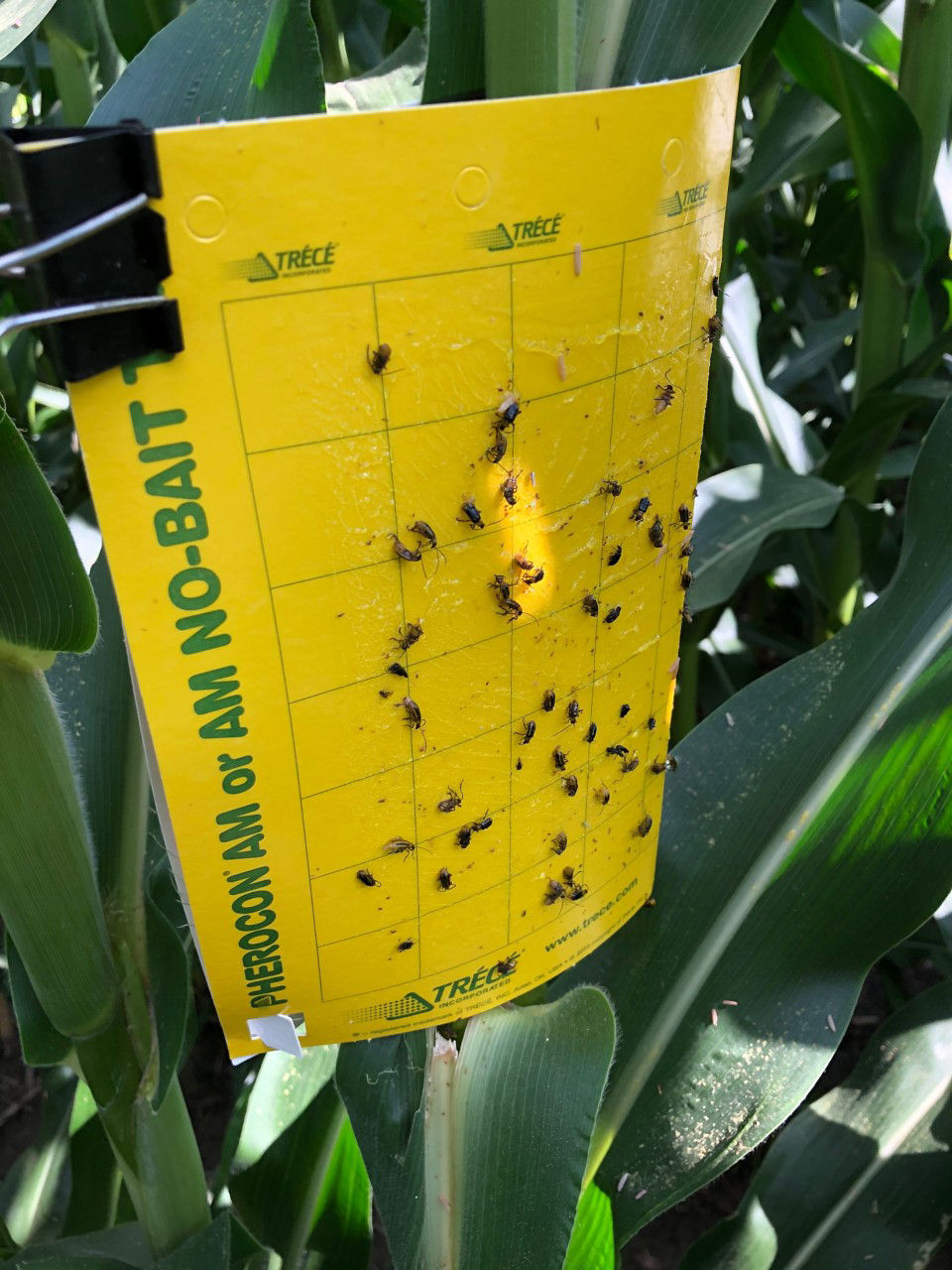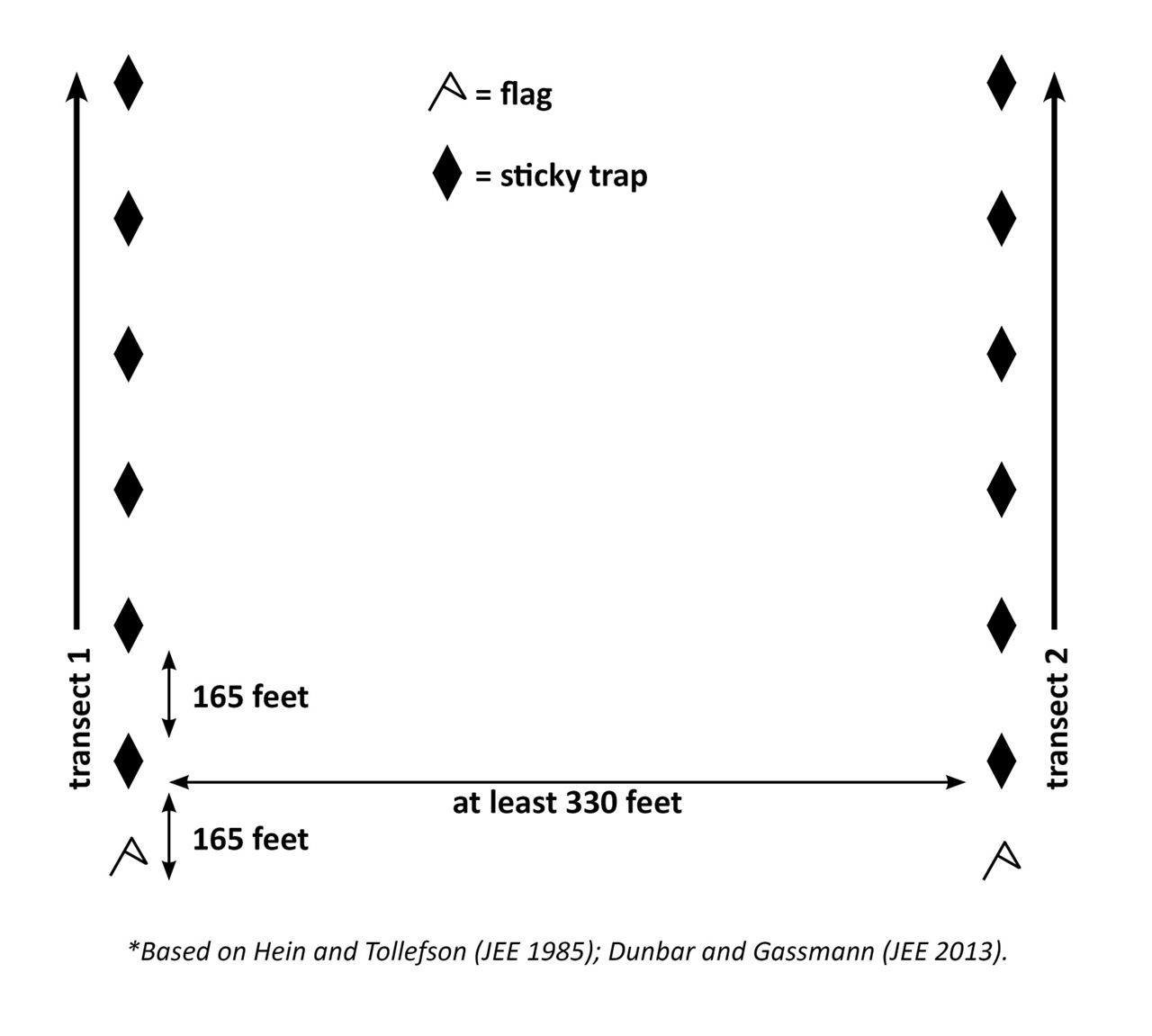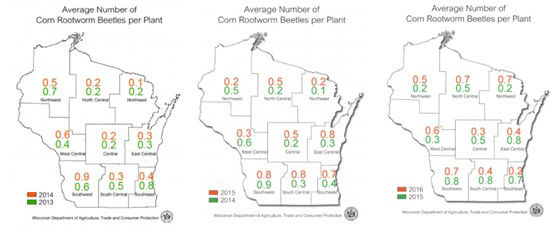7 MIN READ
Management of the Corn Rootworm Complex
May 8, 2023
General Description and Biology of the Corn Rootworm Complex
The corn rootworm complex in the Midwest is considered the most economically damaging insect complex in corn; however, it can be managed effectively by applying integrated pest management concepts. The complex in the Midwest consists of two species, the western corn rootworm (WCR) and the northern corn rootworm (NCR). The corn rootworm complex attacking corn in Texas, Southern Oklahoma, and Southeastern New Mexico consists of two major species, the WCR and the Mexican corn rootworm (MCR). The MCR adult is similar in size to the WCR, but the coloration is different--the MCR is pale green with faint darker stripes on the wing covers and the WCR is yellowish with black striped wing covers (Figure 1). Management strategies that are employed against the complex in the Midwest are also effective against the MCR.

The biology of the WCR and NCR is very similar. They produce a single generation per year and overwinter in the egg stage. Egg hatch begins in the late spring and half of the eggs hatch after approximately 680 to 750 soil-based degree days using a base temperature of 52°F. This usually occurs in late May 10 to early June in the central Corn Belt. The larvae (Figure 2) go through three growth stages, with the entire larval stage lasting about 30 days. In the central Corn Belt, adults can usually be found by July 4th; however, adult emergence can occur well into August. After mating, females deposit eggs in the soil, with most of the eggs deposited in the upper 6-inches of the soil profile.

Variations of Western Corn Rootworm and Northern Corn Rootworm
In Central Illinois, it was observed in the late 1980s that corn following soybean was being economically injured by corn rootworm larvae. This led to the discovery of a WCR variant that fed on soybean leaves and flowers and resulted in the female WCR beetle variant depositing eggs in the soybean field soil. The following year after the soybean crop, corn plants were injured by the WCR variant larvae. Since its discovery in Illinois, there have been reports of the variant in Wisconsin, Indiana, Iowa, and Minnesota. The same technique used to sample WCR in corn can be used to sample soybean fields in areas known to have the WCR variant. Yellow sticky traps should be placed at least 18-inches above the canopy. If a daily average per trap equals or exceeds 1.5 WCR, a control tactic is recommended for the next cropping season. Management tactics are the same as managing the non-variant type. Extending the rotation out of corn for another year, soil applied insecticides, or using a pyramided corn rootworm protected corn product are all viable management tactics. Planting soybean following soybean is not recommended; however, planting winter wheat would be an excellent choice to extend the rotation away from corn as it is not a larval host for corn rootworm.
In the late 1800s, it was observed in Missouri that first year corn was injured by NCR. There were occasional reports of injury to first year corn by NCR reported throughout the 1900s. In the late 1980s, reports of injury to first year corn in Northeast Nebraska and Northwest Iowa became wider. It was discovered that a small number of NCR eggs could overwinter longer than a year before hatching. This phenomenon becomes more pronounced when corn is produced in an, every other year production system. There have been reports of an extended diapause strain occurring outside of the original area, from Minnesota, Missouri, Illinois, and Wisconsin. While the previously mentioned WCR variant deposits eggs in soybean fields that hatch the next year, the NCR extended diapause eggs deposited in corn fields hatch in the second year. Management tactics for the NCR variant are the same as those employed to manage non-variant populations. Since they deposit the eggs in corn fields, the sampling strategy used in corn can be used. If the threshold is reached for NCR, a management tactic should be considered not only in the subsequent cropping season, but the following one as well. Tactics such as extending the rotation to a non-corn crop, applying a soil applied insecticide, or selecting a pyramided corn rootworm product can be effective at controlling NCR.
Management Management of Larval Injury by Sampling Adults
Managing potential injury caused by the larval stage begins with monitoring the adult activity during late July through August of the previous year. Counting adults in corn fields, either on plants or captured on sticky traps, can provide an indication of the risk of larval damage the following year. The use of sticky traps is becoming the standard method to assess the risk of injury.
Counting Adults Using Sticky Traps in Corn1
For every 10 to 50 acres of corn, select two corn rows, separated by at least 300 feet and at least 165 feet from the field margin. Place six sticky traps (e.g. Pherocon® AM no-bait), in each row separated by 165 feet. Attach the trap directly above the ear, removing leaves that may get tangled in the trap. Mark the row, so it can be easily found. Place the traps at silking and count the total number of WCR and NCR beetles every week and replace the trap. Determine the average number of corn rootworm beetles per trap per day. For example, a total of 100 beetles captured on 12 traps over a week would be an average of 1.2 beetles per trap per day (100/12 = 8.3; 8.3/7 = 1.2 beetles/trap/day). If at any time during the sampling period the number of beetles exceeds an average of 2 beetles per trap per day, a control tactic is recommended for the next growing season. The trapping period should last at least four weeks.
In areas with the NCR variant, if the number of NCR adults exceeds two beetles per trap per day, then injury may occur in two years.

Counting Adults on Sticky Traps in Soybeans
In areas where the WCR variant is present, soybean can be sampled using the same technique that is used in corn. Place sticky traps at least 18-inches above the canopy. If a daily average per trap equals or exceeds 1.5 WCR, a control tactic is recommended for next cropping season.

Management Tactics if Beetle Counts
Exceed the Threshold Management tactics include:
- Crop rotation to a non-corn crop
- Corn is the only agronomic crop in which the corn rootworm complex can complete its life cycle. If beetle counts exceed the threshold, rotating to a non-corn crop is the most effective known control. In areas where the NCR variant occurs, rotation away from corn should be for two years.
- Corn product selection that contains a pyramided below-ground corn rootworm protection trait
- A pyramided corn product is one that has been genetically modified to produce at least two proteins directed towards a single pest. For products containing SmartStax® PRO technology, there are two Bacillus thuringiensis (Bt) proteins (Cry34/35Ab1 and Cry3Bb1) that are active against corn rootworm larvae. For products containing SmartStax® PRO with RNAI Technology, there is an additional mode of action from DvSnf7 dsRNA.
- Insecticides
- Insecticides can be applied at planting or with a layby application prior to egg hatch to suppress economic injury by the corn rootworm larvae. This should be only done on non-rootworm traited corn. Consult your local state extension office for local recommendations.
- An aerial application of insecticide to kill beetles prior to egg laying is a tactic that has been used for several years. Timing and determining the number of beetles in the field is critical with this tactic. In addition to determining the abundance of corn rootworm beetles, the percentage of gravid (those females with eggs that are ready to be deposited) females must be determined. The recommended threshold is 0.75 beetles per plant, regardless of plant population, and 10% of the females are gravid. Multiple applications may be required to suppress beetle populations below the threshold and prevent subsequent larval damage the following cropping season. Including an insecticide with a fungicide application at R1 growth stage for the purpose of controlling beetles and larvae the following season is not recommended unless beetles reach the threshold.
Resistance to Bacillus thuringiensis
In the early 2010s, it was reported in Iowa that populations of WCR had become resistant to the Cry3Bb1 Bt protein.1 Additional resistant populations have been identified in Nebraska2, Illinois3, and Minnesota4. Some populations with resistance to the Cry3Bb1 protein are also resistant to the mCry3A and eCry3.1Ab Bt proteins. There has also been confirmed resistance to the Cry34Ab1/Cry35Ab1 Bt protein.5 The newly available SmartStax® PRO with RNAi Technology corn products may be an option for areas with resistant WCR populations.
Common Questions and Answers on Corn Rootworm Management
Corn rootworm populations in my area have been very low for the past couple of years, do I still need to manage for them?
It is hard to answer this question directly. Corn rootworm populations can fluctuate dramatically from year to year. Figure 5 of actual corn rootworm beetles per plant in Wisconsin provides an illustration of the year-to-year variability in corn rootworm populations. Therefore, the best management practice is to scout at risk fields annually.

Should I sample my first-year corn field if I am planning on planting corn there next year?
Yes. Corn rootworm females generally mate in the field where they emerge. Females usually disperse more readily than males; therefore, first year corn fields usually contain a higher percentage of female beetles. Corn planted later than surrounding corn fields may be more attractive to dispersing females if the field is beginning to silk and shed pollen compared to earlier-planted fields in which silks have begun to brown. Additionally, if the WCR variant or the NCR extended diapause exist in your area, first year corn may be at risk. In the case of the WCR variant, females will deposit eggs in the previous year’s soybean crop. The extended diapause trait in NCR allows the eggs to overwinter two years prior to hatching. Both can result in corn rootworm injury to first year corn. If the field or farm has observed corn rootworm injury to first year corn, consideration should be given to incorporating a corn rootworm larval control tactic such as a corn product with below ground Bt traits.
Do I need to sample all my corn fields?
It depends. If your crop production system is a strict corn and soybean rotation, then there would be no need to sample the field in areas where the NCR extended diapause or WCR variant does not exist. However, if you have experienced injury to first year corn and NCR is a suspected species, then the field should be sampled to identify the risk for injury in two years when corn is produced in the field. If WCR is the suspected species, then field does not need to be sampled, but the soybean field should be sampled for WCR beetles as described above.
Can I use larval sampling to determine the need to use a rescue treatment?
Larval sampling can be used to detect the presence of corn rootworm larvae. The general economic action threshold is if two or more larvae per plant are found, a treatment may be warranted. Usually by the time larvae are detected, there isn’t enough time to treat to prevent economic loss.
Can I use an insecticide to kill the beetles before enough eggs are deposited to result in economic injury?
This tactic has been used with some success in the past. Timing is critical with this tactic. Count the beetles on the plants and if a threshold is reached, usually 0.7 to 1 beetle per plant and 10% of the females are gravid (ready to deposit eggs), an insecticide is recommended.
Does tillage have an impact on the population?
Fall or spring tillage does not have an impact on egg survival.
Will a cold winter kill the eggs?
Yes, but it depends on how cold, duration of the cold spell, rootworm species, soil texture, and possibly snow cover and tillage system. In general, NCR can withstand colder temperatures for a longer period than WCR. Fields without snow cover or crop residue may experience colder temperatures. Research has found that if soil temperature is maintained at or below 14°F for two to four weeks substantial mortality of WCR eggs can occur.8
Sources:
1Hodgson, Erin. 2016. Guidelines for using sticky traps to assess corn rootworm activity. Integrated Crop Management. Iowa State University Extension. https://crops.extension.iastate.edu/cropnews/2016/06/guidelines-using-sticky-traps-assess-corn-rootworm-activity.
2Seiter, N., Spencer, J., and Estes, K. 2018.Managing corn rootworm populations in Illinois: Considerations for 2018. farmdoc. University of Illinois Extension. https://farmdoc.illinois.edu/field-crop-production/insects/managing-corn-rootworm-populations-in-illinois-considerations-for-2018.html/.
3Gassmann, A.J., Petzold-Maxwell, J.L., Clifton, E.H., Dunbar, M.W., Hoffmann, A.M., Ingber, D.A., and Keweshan, R.S. 2014. Field-evolved resistance by western corn rootworm to multiple Bacillus thuringiensis toxins in transgenic maize. Proceedings of National Academy of Science. Vol. 111, pp. 5141–5146.
4Wangila, D.S., Gassmann, A.J., Petzold-Maxwell, J.L., French, B.W., and Meinke, L.J. 2015. Susceptibility of Nebraska western corn rootworm (Coleoptera: Chrysomelidae) populations to Bt corn events. Journal of Economic Entomology. Vol. 108, pp. 742–751.
5Gray, M. 2014. Field evolved western corn rootworm resistance to Bt (Cry3Bb1) confirmed in three additional Illinois counties. farmdoc. Department of Crop Sciences. University of Illinois at Urbana-Champaign. https://farmdoc.illinois.edu/field-crop-production/uncategorized/field-evolved-western-corn-rootworm-resistance-to-bt-cry3bb1-confirmed-in-three-additional-illinois-counties.html.
6Zukoff, S.N., Ostlie, K., Potter, B., Meihls, L., Zukoff, A., French, L., Ellersieck, M., Wade French, B. and Hibbard, B. 2016. Multiple assays indicate varying levels of cross resistance in Cry3Bb1-selected field populations of the western corn rootworm to mCry3A, eCry3.1Ab, and Cry34/35Ab1. Journal of Economic Entomology. Vol. 109, pp. 1387-1398.
7Gassman, A.J., Shrestha, R.B., Jakka, S.R.K., Dunbar, M.W., Clifton, E.H., Paolino, A.R., Ingber, D.A., Wade French, B., Masloski, K.E., Dounda, J.W., and St. Clair, C.R. 2016. Evidence of resistance to Cry34/35Ab1 corn by western corn rootworm (Coleoptera: Chrysomelidae): root injury in the field and larval survival in plant-based bioassays. Journal of Economic Entomology. Vol. 109, pp. 1872–1880.
8Gustin, R.D. 1981. Soil temperature environment of overwintering western com rootworm eggs. Environmental Entomology. Vol. 10, pp. 483-487.
Websites verified 4/5/23 1215_67583